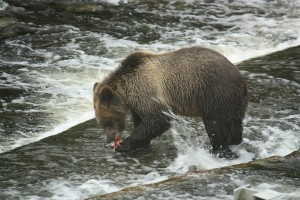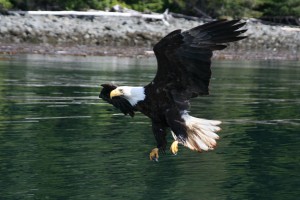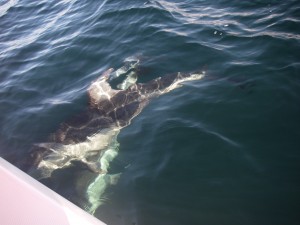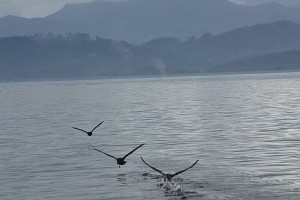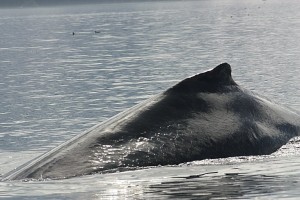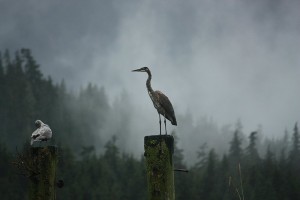All posts by Lodge Guide
Grizzly Bear viewing close up
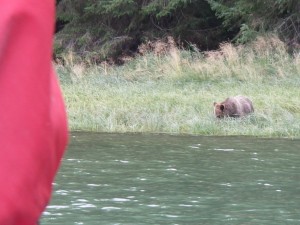
The red coat in the corner of the picture is intentional to show how close the grizzly bear viewing can become. The grizzly bear tours travel up Knight Inlet to the Glendale River where we tie to a float and transfer to a sixteen-foot aluminum skiff to view the bears along the shore and in the river estuary. The loaded skill only draws about eight inches of water and when the depth is about two feet your guide, in waders, enters the water to move the boat along the shore or up the river. At times I have had guests ask me to move back a little, as they did not want to change their lens again. The grizzlies are normally so intent with eating the sedge grass that they do not acknowledge our presence and only look up to swallow before they return to grazing. The photo date in August 18th so we are viewing in the estuary and with the bears waiting for the salmon to arrive. NOTE enlarge the photo
Pacific White-sides coming close
Pacific white-sided dolphins may be viewed on any of the tour days whether it is for grizzly bears, whale watching or on a trip to visit Trapper Rick on your extra day visiting Grizzly Bear Lodge. Vancouver Aquarium’s AquaFacts state “Pacific white-sided dolphins are present in First Nations middens dating back 2,000 years, but they were rare in B.C. during the 19th and 20th centuries. Starting in the 1980’s, Pacific white-sided dolphins started to become more abundant in inshore waters and inlets along the B.C. coast. It’s possible that their long absence was related to a change in ocean temperatures and a shift in their prey distribution. In the entire North Pacific, there are estimated to be approximately 900,000 Pacific white-sided dolphins. Dolphins travel in groups throughout their lives. In B.C., Pacific white-sided dolphins are usually encountered in groups of 10 – 100 animals, although some groups have been seen with 2,000 or more individuals.” As Lynn Morris’s photo indicates these dolphins are curious and if we are near a large pod they will come and play in the bow wake, if we stop they will swim beneath the boat.
Grizzly bears watching and waiting
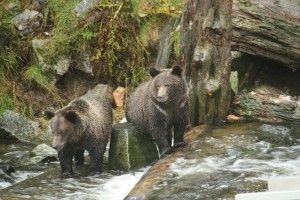
These grizzly bear siblings seem to be old enough to fish on their own but they appear to be waiting for something to happen. It could be the lack of salmon in the river or that other larger dominant bears have moved then to the sidelines. It could be perspective on my part in that when you do not have another bear use for size comparison maybe they are just very fat two year olds waiting for mother to provide another meal. However at two they should be fishing because next year they would normally be on their own. At times the cubs stay with mother more than two years and if she is not pregnant cubs may stay with their mother for four years.
Guests being ignored
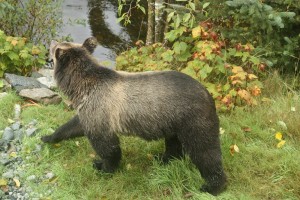
“If I don’t look at you are not there.” The grizzly bear tours from the lodge, after August 24th, are permitted to travel up the Glendale River to the man-made spawning channel and use one of the two viewing stands. These brown bears have accepted or presence and will pass close and at times underneath the stands. They seem to show no fear but loud noise, flashes from cameras or sudden movement will cause them to move off the river.
Surf scoters departing
Large flocks of surf scoters while wildlife viewing are common in Knight Inlet as well as the area of Johnstone Strait where we spend our day’s whale watching. The abundance of food for these ducks in the form of herring is shown in the difficulty that they have leaving the water. They appear to be running on the water while trying to build up enough speed to become air born but it is common to see the ducks abort a take off and go for the dive to get out of the way of approaching boats. Maybe this is why airlines are so careful when calculating their payload, as they would find an abort with a dive rather uncomfortable.
Humpback whale dive
Is a good lens to get a close up picture of a humpback whale about to dive? The tell tail sign of a humpback whale about to dive and provide a opportunity for a picture of its tail is the thrust of its back higher out of the water as it noses down for a deep dive. A long telephoto lens is not a necessity as we normally have lunch with the whales. On our whale-watching safari, after a short bathroom break in Telegraph Cove on Vancouver Island, we head toward Bold Head an area frequented by humpback whales. Once there we cut the motors and drift while we have a picnic lunch. At this time it is not uncommon to have the whales come close enough to eliminate the need for long lenses in fact I have had guests comment that they could not get the whole whale in the photo. An excellent whale shot captures by UK’s Lynn Morris.
Great Bear Rainforest heron
A misty morning in the Glendale River estuary and Lynn Morris captures a great blue heron the safest way. Our wilderness tours leave the lodge by eight in the morning for the hour and quarter run along the shores of Knight Inlet with a constant lookout for wildlife. Wildlife seen like the ever present bald eagles, frequently black bears, often pacific white-sided dolphins and on the rare occasion killer whales. Most days the run up the inlet is fog free and the few days there is fog it clears part way up the inlet. This appears to be a day with a low mist coming down the inlet and adding to the mystery and excitement in a grizzly tour. Heron are normally seen wading shores, in the river, walking on kelp beds or the lodges log breakwater looking for food on pilings less common. Even thought they do nest in trees I still find it hard to accept when I see this long legged bird sitting in a fir tree along the shore.
Pink salmon in the Glendale River
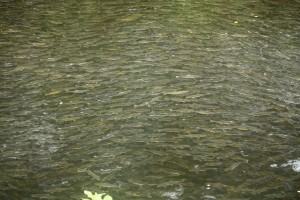 The reason the grizzly bears travel over a hundred miles through the Great Bear Rainforest of BC to the area of the Glendale River is the number of pink or humpy salmon that return each year to the man-made spawning channel. This photo by Lynn Morris shows the abundance of the salmon during the peak of the run. The travel distance was documented about ten years ago when ten bears were fitted with radio (GPS) collars to determine their den area to see if proposed logging would do any harm.
The reason the grizzly bears travel over a hundred miles through the Great Bear Rainforest of BC to the area of the Glendale River is the number of pink or humpy salmon that return each year to the man-made spawning channel. This photo by Lynn Morris shows the abundance of the salmon during the peak of the run. The travel distance was documented about ten years ago when ten bears were fitted with radio (GPS) collars to determine their den area to see if proposed logging would do any harm.
Grizzly bear eating salmon
